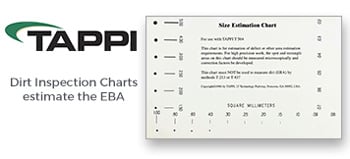 Search
Search
Use the search bar or filters below to find any TAPPI product or publication.
Filters
Publications
Level of Knowledge
Collections
Journal articles

Magazine articles

Fiber-Based Solutions: Sustana Mill Optimization for Dry Bale Production, Paper360º March/April 2024
Journal articles

Magazine articles

Improving refining efficiency with deflocculation, TAPPI Journal May 2022
ABSTRACT: The ability to load a refiner requires the formation of a fiber mat between opposing refiner bars. One of the consequences of this is the formation of flocs that persist through the refiner grooves and exit the refiner. These flocs interfere with sheet strength, requiring additional energy to make up the strength deficit. In addition, flocs can initiate string formation, resulting in machine efficiency issues such as cross-machine profile deterioration and the downtime required to correct it. Novel refiner plate modifications have been shown to improve refining efficiency in otherwise identical refiner plates. Energy savings are typically around 15% of gross refining energy on the basis of the treated stock, although much higher reductions have also been seen. Addressing this previously underappreciated flaw in conventional refining enables greenhouse gas reduction and other benefits related to sheet strength and machine efficiency.
Journal articles

Magazine articles

Fiber-based characterization of pulp refining, TAPPI Journal September 2022
ABSTRACT: Fiber development in pulp refining can be characterized by three parameters: number of impacts on pulp, N; energy per impact, I, and bar force on fibers, F. These parameters enable comparisons of radically different refining conditions; determination of intensity for hardwoods and softwoods; assessment of effect of bar width on fiber shortening; and predictions of tensile strength increases.
Journal articles

Magazine articles

Compression refining: the future of refining? Application to Nordic bleached softwood kraft pulp, TAPPI Journal August 2024
ABSTRACT: A new compression refining technology based on the kneading of high consistency pulp has been selected and tested in various conditions with a model Nordic bleached softwood kraft (NBSK) pulp. The method uses a kneader mixer referred to as the ultra continuous mixer (UCM) to condition the pulp. Its performance levels were also compared with those obtained with traditional low consistency (LC) refining of the same pulp.Compression refining of the NBSK pulp with the UCM led to a much better °SR/strength compromise than conventional LC refining. High strength properties can also be achieved by compression refining, in a range similar to/or better than LC refining. The higher the strength required, the greater the advantages of this technology: for a given strength, a difference of up to 10°SR can be obtained as compared to LC refined pulp. Moreover, a higher tear index can be obtained with compression refining, since fiber cutting is greatly reduced.The lower °SR is due to the release of fewer cellulosic fines, which also results in the manufacturing of new papers combining a high strength and a high permeability that cannot be obtained with traditional LC refining. Indeed, with LC refining, a high strength is generally associated with a low permeability. Upscaling this technology seems to be possible since large production devices are already on the market for applications other than paper/pulp. With this new pulp behavior, papermakers will have to learn to think differently, as paper strength and °SR can now be decorrelated.
Journal articles

Magazine articles

Characterizing rheological behavior and fluidization of highly refined furnishes, TAPPI Journal April 2024
ABSTRACT: In this work, highly refined softwood bleached kraft pulp (SWBKP) furnishes, referred to here as XFC, were studied from the perspective of fiber suspension handling in processing. The rheology of the furnishes was studied with a rotational rheometer using a non-standard flow geometry to understand the viscosity development at different consistencies and the impact of temperature. For fluidization analysis during pipe flow, two optical methods were implemented; namely, optical coherence tomography (OCT) and high-speed video (HSV) imaging. The OCT was used to determine the small-scale floc structures near the pipe wall where the shear stress is highest, and the HSV imaging was applied for observing flow instabilities and XFC suspension uniformity at the pipe scale. All these issues can be significant in deciding the minimum flow rate required for a process pipe to get sufficient fluidization of XFC suspensions.
Journal articles

Magazine articles

Effects of a PFI refiner’s operational parameters on the swellability of recycled fiber, TAPPI Journal May 2020
ABSTRACT: This paper presents data on the effects of operational parameters (number of revolutions, linear pressure, and gap) of the PFI refiner on the swellability of recycled fiber, which was characterized by water retention value (WRV). The results showed that the increase of recycled fiber’s WRV was proportional to the number of revolutions and the linear pressure, but inversely proportional to the gap. The mathematical relation between these parameters and the fiber WRV could be described by an empirical model for gaps greater than 0.1 mm. Scanning electron microscopic images of fiber morphology showed that the basic framework of fibers could be maintained with the gap greater than 0.1 mm, but was destroyed with smaller gaps. This model provides a technical reference for quantitative control of refining treatment and an effective method for improving recycled fiber quality.
Journal articles

Magazine articles

External fibrillation of wood pulp, TAPPI Journal June 2023
ABSTRACT: Pulp refining produces external fibrillation consisting of fibrils tethered to fiber surfaces, in addition to loose fibrils and fines. Both contribute to a larger bonding area that increases paper strength, but tethered fibrils have less likelihood of being washed out during papermaking. This study postulates the mechanism by which refining produces external fibrillation and the optimum conditions for doing so.The postulated mechanism is surface abrasion during sliding of fibers in refiner gaps. External fibrillation occurs when forces are great enough to partially dislodge fibrils from fiber surfaces, but not large enough to break the fibrils. The refining intensities to achieve these forces were determined by a mathematical model and experiments using a laboratory disc refiner. The optimum intensities in terms of specific edge load (SEL) for chemical pulps were about 0.1 J/m for hardwoods and 1.0 J/m for softwoods. An extension of this study suggested that abrasion may also account for most of the energy consumed in the mechanical pulping process.
Journal articles

Magazine articles

Mechanical modification of softwood pulp fibers using a novel lightweight vertical bar plate, TAPPI Journal April 2021
ABSTRACT: Refiner plates made using sand casting have a draft angle, which results in a trapezoidal bar shape. These trapezoidal bar plates have a limited throughput compared to the vertical bar plates, and eventually the edges of the bars become dull, resulting in longer time to reach the target freeness and shorter service life. The new light-weight refiner plate with a bar insertion method into a plate base was developed by selecting an aluminium-based alloy as the plate base material and a stainless steel alloy with high wear resistance as the bar material. The light-weight plate with sharp bar edges was very effective in reducing refining energy by reaching the target freeness faster than the sand-cast bar plate. Finally, the lightweight sharp bar plate, which weighed only about half the weight of the cast bar plate, was expected to significantly contribute to easy replacement, improved paper quality, and larger throughput without excessive loss of fiber length.
Journal articles

Magazine articles

The Shortest Route to Fiber Quality, Paper360 May/June 2019
The Shortest Route to Fiber Quality, Paper360 May/June 2019
Journal articles

Magazine articles

Use of fines-enriched chemical pulp to increase CTMP strength, TAPPI Journal April 2021
ABSTRACT: In this study, fines-enriched pulp (FE-pulp)—the fine fraction of highly-refined kraft pulp—was benchmarked against highly-refined kraft pulp (HRK-pulp) as a strength agent in eucalyptus chemithermomechanical pulp (CTMP). Both the FE-pulp and the HRK-pulp were produced from unbleached softwood kraft pulp, and equal amounts of those strength agents were added to the original CTMP, as well as to washed CTMP, where most of the fines had been removed. The effects of the added strength agents were evaluated with laboratory handsheets.The FE-pulp proved to be twice as effective as HRK-pulp. Both HRK-pulp and FE-pulp increased the strength of the CTMP handsheets. The bulk of the handsheets decreased, however, as well as the drainability. The addition of 5% FE-pulp resulted in the same strength increase as an addition of 10% HRK-pulp, as well as the same decrease in bulk and CSF. For the handsheets of washed CTMP, the strengths were not measurable; the CTMP lost the sheet strength when the CTMP-fines content was reduced through washing. The reduced strength properties were compensated for by the addition of chemical pulp fines that proved to be an efficient strength agent. The addition of 5% FE-pulp restored the strength values, and at a higher bulk and higher drainability.





